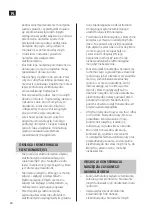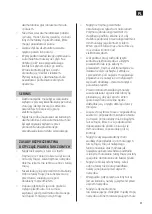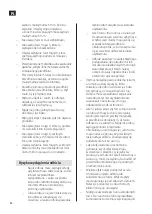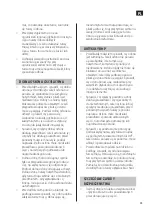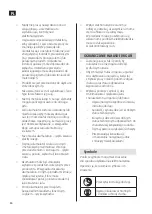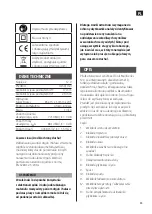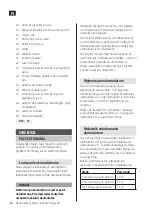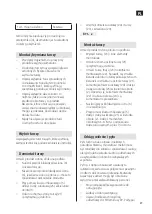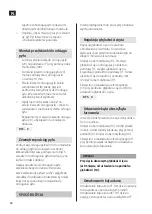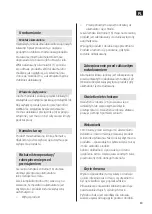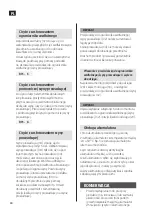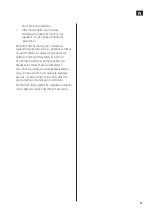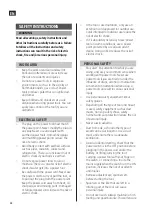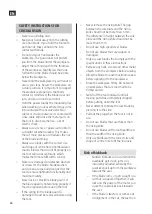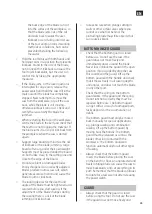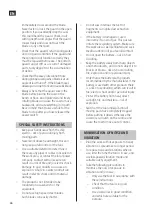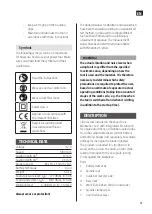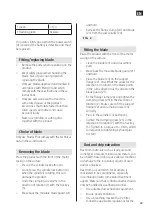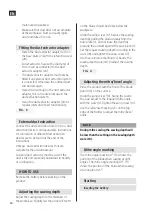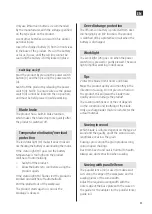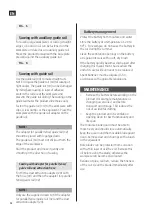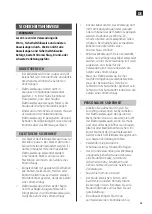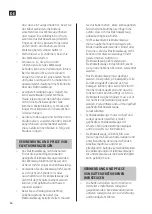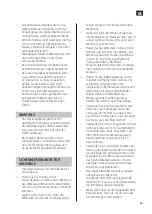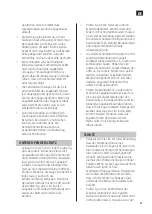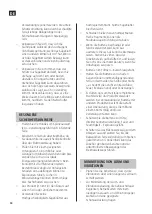
EN
44
SAFETY INSTRUCTIONS FOR
CIRCULAR SAW
• Never use grinding discs.
• Keep your hands away from the cutting
area and blade. If you hold the tool with
both hands, they cannot come into
contact with blade.
• Do not put your hand under the
workpiece. The guard does not protect
you from the blade under the workpiece.
• Adjust the cutting depth to the thickness
of the workpiece. Slightly less than one
full tooth on the blade should be visible
below the workpiece.
• Never hold the workpiece in your hands or
across your legs. Secure the workpiece on
a stable surface. It is important to support
the workpiece properly so that body
contact is minimised, the blade does not
jam, and you do not lose control.
• Hold the power tool by the insulated grips
when working in areas where it may come
into contact with concealed electrical
cables or its own power cord. Contact with
a live cable will cause the metal parts on
the tool to also become live – risk of
electric shock.
• Always use a fence or guide rail to obtain
a straight cut when sawing. This makes
the cut more precise and reduces the risk
of the blade jamming.
• Always use blades with the correct size
and shape of centre hole (rhomboidal or
round). Blades that do not fit properly on
the tool will run eccentrically, which
makes them more difficult to control.
• Never use damaged or defective washers
or screws for the blade. Blade washers
and screws are specially designed for the
tool to ensure optimum functionality and
maximum safety.
• Never lock, or block the blade guard. If
the blade guard is not working properly it
must be repaired before using the tool.
• If the spring for the blade guard is
damaged it must be replaced before using
the tool.
• Never remove the riving knife The gap
between the sole plate and the riving
knife should not be more than 5 mm.
The difference in height between the sole
plate and the riving knife should not be
more than 5 mm.
• Do not use high-speed steel blades.
• Do not use blades that are warped or
damaged.
• Only use saw blades that comply with the
specifications in these instructions.
• Remove any nails, screws and other metal
objects from the workpiece before sawing.
• Allow the blade to reach maximum speed
before applying it to the workpiece.
• Brace the workpiece firmly. Do not work
on workpieces that are too small to be
firmly secured.
• Switch off the tool and wait until all
moving parts have completely stopped
before putting down the tool.
• Never attempt to brake the saw blade by
pressing it to the side.
• Pull out the plug when the tool is not in
use.
• Do not use blades that are thicker than
the riving knife.
• Do not use blades with a tooth width less
than the width of the riving knife.
• Only use blades with the correct size and
shape of centre hole to fit the tool axle.
Risk of kickback
– Sudden kickback can occur when the
saw blade gets stuck, jams or is
incorrectly adjusted, whereby the
saw kicks back up from the workpiece
towards the user.
– If the blade jams, or gets caught in a
cut that is squeezed together, it will
lock and the power of the motor can
cause the saw to kick back towards
the user.
– If the blade is twisted, or comes out
of alignment in the cut, the teeth on
Содержание 019803
Страница 4: ...1 2 11 12 13 14 15 16 17 18 19 20 22 21 1 2 1 2 3 4 5 6 7 8 9 10 ...
Страница 5: ...3 4 5 23 24 25 26 14 13 27 28 60 mm ...
Страница 6: ...6 7 28 30 29 ...

